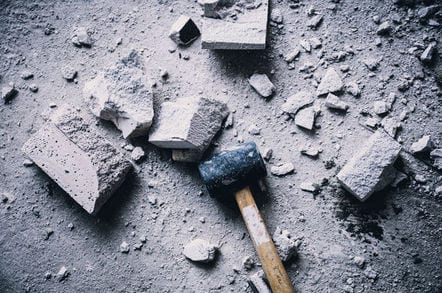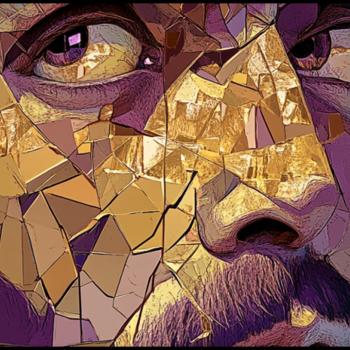
When you demolish a building you take everything down to the foundation and stop. At least, that’s what you do if you plan to rebuild a brand-new structure in the same spot.
For those who have deconstructed their Christian faith, finding that foundation can be challenging. Sometimes it can feel as if you’re just pounding rocks in the darkness. One day you look around and realize that you’ve torn everything down to dirt beneath the foundation because you weren’t sure when – or even how – to stop deconstructing your faith.
The process of deconstruction is, at its core, about asking questions and testing what you once believed to see if it holds up. If it does, you hold on to it. If it doesn’t, you toss it away. But sometimes you toss away something too quickly and then it’s hard to get it back. Other times, you hang on to something that really should have let go of and it’s hard to walk away; either for emotional reasons or just simply because your faith was dependent on that one belief a little more than you realized.
Navigating this process of deconstruction can feel like wandering around with your eyes blindfolded. You’re not sure who to trust. You’re not sure if you even need to depend on anyone else or not. Uncertainty is the only thing you feel certain about. Doubt is the only thing you believe in. Questions are the only answer. It’s almost easier to walk away than to stay and sort through the junk drawers of our childhood faith.
So, we do. We walk away. We wander around. We meander.
And, to be honest, for a while that feels pretty good. The freedom that comes from not giving a crap anymore is intoxicating. We find ourselves on the outside looking in and – even if it’s a little bit painful – it starts to feel like home.
But, eventually, we either grow tired of our nomadic faith journey in the wilderness, or we simply find ourselves longing for some connection with the Divine again. The problem is, we’re so far out to sea we’re not sure which direction the shore might be. We’ve jettisoned our compass and our map. We’ve forgotten our way back and – to be really honest – we’re not even sure if we can trust ourselves not to end up entangled in another toxic faith quagmire like we just escaped from.
Is it even worth it to try again? Is the risk of reconstructing our faith worth the dangers of possibly constructing another system that one day we’ll have to deconstruct from once more?
These are just the questions we find ourselves asking, and some of us answer those questions in different ways. Some of us say it’s not worth it. Others are happy just floating along on their own. Still others come to the conclusion that most of what they’ve deconstructed from wasn’t from God in the first place. They realize that there’s a very strong possibility that God is still real, and alive, and out there – or in here – and has never once been further away than their very own heartbeat.
For those who still hope, and who still yearn for that Divine connection, there is still the possibility of rebuilding a new faith and reconstructing a fresh experience with God outside the established systems they’ve left in their rear view mirror.
Only a few make it this far. In my experience, far too often, people who begin to deconstruct either tear everything down and lose their faith completely, or they stop short of fully deconstructing out of fear of the unknown. A few just take it really slow and try to avoid the inevitable because they’re really not sure what they’re going to do when the deconstruction ends and the time for reconstruction begins.
For those few who find themselves at the end of their deconstruction process – or at least “near” the end, since our posture of admitting we don’t know everything should never cease – there is hope for reconstruction.
But, before we can start to reconstruct our faith, we have to find our foundation. We need to make sure it’s smooth and firm and steady enough to rebuild something on that will withstand the next storm of doubt and questions.
So, what does that foundation look like? I think it looks something like this:
*Our foundation should be simple. Nothing complicated. Nothing constructed out of intricate theories and doctrines and proof texts. We don’t need a Greek lexicon or a Hebrew commentary. We just need a few simple concepts to guide us. Anything more complicated that “God is good and we are loved” should be forcefully whittled down until it can fit snugly into the palm of our hand, or the back pocket of our heart.
*Our foundation should be our own. We don’t need to borrow someone else’s blueprint for our foundation. Our foundation is personal. It’s something we’ve built with our own two hands. If anyone looks close enough they should be able to see our fingerprints in the texture of our foundation. That’s how we know it’s ours and not someone else’s.
*Our foundation is only the foundation, not the entire structure. That means we need to ensure that our foundation – as simple and personal as it is – doesn’t need to tell the whole story. It only needs to provide a platform we can use to slowly reconstruct our new faith upon when the times comes.
*Our new foundation needs time to dry and settle. Having taken our faith down to the bedrock, we need to take time to sweep it off, clean it down and allow it some time to rest before we start our reconstruction work. In other words, there’s no big hurry. We owe it ourselves to allow some time between deconstruction and reconstruction. We’re not punching a clock. No one else’s expectations should drive our reconstruction process. This project will start when we’re ready. It will take as long as it takes. We might even take a few days off for the holidays. There’s no need to rush this job. No one wants to live in a house that was built for speed rather than craftsmanship.
*Our foundation should be something we’re as sure of as we can be. However, this doesn’t mean that our foundation doesn’t involve some measure of faith. Remember, we’re learning how to embrace the beauty of mystery and unknowing. Certainty isn’t our goal. We’re comfortable with wonder. We’re enamored with awe. So, while our foundation should be reasonably secure, it’s ok if it’s not entirely provable scientifically. We’re not looking for a theorem backed by an equation. We’re looking for a simple statement and belief that under girds our new faith paradigm.
*Our foundation can be revised over time. Nothing is written in stone. We’re free to edit and revise as we go. Being right is less important to us than our ability to admit when we’re wrong. If nothing else, maybe our foundation is simply this: We could be wrong. We’re open to truth. We’re interested in what brings us life and sets us free.
Whatever your foundation ends up being, it’s really important that you know what it is before you start to reconstruct your faith. Otherwise, you won’t get very far before you watch it all fall down again and you end up starting over again.
If you’ve deconstructed your faith and you’re ready to move on to reconstruction, I hope you find your firm foundation. I hope you build slowly, but strong. I hope you find beauty in every stone you place upon the other. I hope what you build on that foundation brings you hope and joy and laughter and life.
I hope you find freedom on the other side.
**
If you’re yearning for reconstruction, I’d love to invite you to join me for a 90 day journey that starts on Monday, Jan. 13, 2020. You can learn more about it at Square 1.
**
Keith Giles was formerly a licensed and ordained minister who walked away from organized church 11 years ago, to start a home fellowship that gave away 100% of the offering to the poor in the community. Today, He and his wife are returning to El Paso, TX after 25 years, as part of their next adventure.
Can’t get enough? Get great bonus content: Patreon page.













